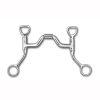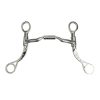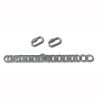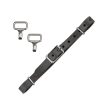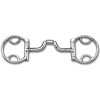Measure Your Horse
The bit is a vital tool that facilitates communication between rider and horse and for the best possible results you need to ensure that you select a bit that sits as comfortably as possible in your horse’s mouth. This isn’t always a straightforward process given that horses’ mouths vary as much in terms of size and composition as human mouths do. However, one thing you should always do before buying any kind of bit for your horse is measure their mouth.
We must first point out that Myler bits are somewhat different to most other bits available in that their design is curved to provide some added room for the horse’s tongue. Additionally, a Myler bit will almost always measure slightly larger than its advertised size (typically 1/8″ bigger) since the Myler brothers believe that it’s beneficial to performance if there’s 1/8″ to 1/4″ of bit showing on each side of the horse’s mouth.
In order to get the most accurate measurement of your horse’s mouth, you’ll need either a wooden dowel or a similarly shaped piece of wood (using the handle of a wooden spoon isn’t uncommon). You can get the measurement by doing the following:
- Put the dowel in the horse’s mouth where the bit is typically positioned.
- Allow the horse to become relaxed (they often chew the dowel at first).
- Take a marker pen and put a mark on the dowel where the horse’s lips end.
- Take a measuring tape and measure the distance between these two marks.
You should then use this measurement when selecting a new bit and always choose the next size up if you can’t find an exact match. Going down a size can often result in the bit being too tight a fit, thus putting more pressure on the mouth. The most commonly selected bit sizes are 5″, 5 1/2″ and 4 3/4″. You should notice the following signs if you’ve selected the correct size of bit for your horse:
- As already mentioned, there should be between 1/8″ and 1/4″ of the bit visible on each side of the mouth when the bit is correctly seated.
- The cheekpiece should not sit tight against the face of the horse, as this often leads to either rubbing or chaffing, both of which are unconformable for the horse.
Signs That Your Horse Needs a New Bit
Horses only communicate in two ways; through relaxation and resistance/evasion. If you’ve noticed your horse either resisting or evading your commands, it’s a sure sign that they are not happy with the bit that you’re using. If you’re using the Myler bitting system, in this situation we would recommend that you select a bit that applies less tongue pressure (and is therefore softer), rather than one that applies more (and is therefore harsher). This is because a horse resists or evades when it seeks more tongue relief. Some of the most common signs of resistance include:
- Attempting to go behind the bit
- Attempting to go above the bit
- Opening the mouth fully
- Pushing the tongue out of the side of the mouth
- Pulling the tongue back up the throat
- Pushing the tongue up and over the bit
A horse will try to do these things as it seeks greater tongue relief and a greater level of comfort. In addition to indicating that the bit needs replacing with a different mouthpiece, this behavior also goes a long way to proving that it is excessive tongue pressure, rather than bar pressure, that causes a horse to become evasive, since many of the actions above will increase the pressure on the horse’s bars while reducing pressure on its tongue. If your horse doesn’t display any evasive behavior, you should never change the bit you are using.

